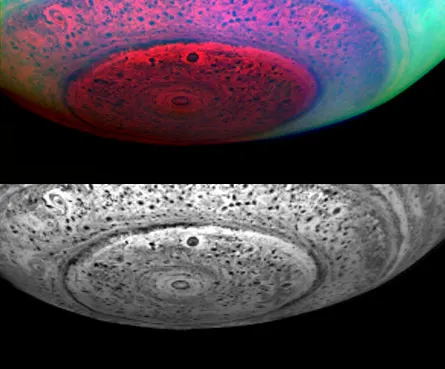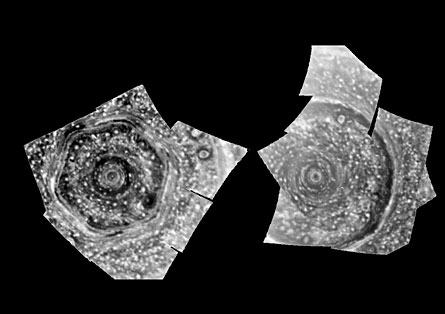Huge cyclone churns at Saturn’s north pole
The closest look yet at the ringed planet’s poles offers detailed views of massive storms, with strange differences between north and south.
Hurricanes Ike and Katrina can’t hold a candle to the giant storm centers on Saturn. Planetary scientists have gotten their closest look yet at polar hurricanes on the ringed planet, and find that the storms are big enough to engulf Earth.


Researchers unveiled the images on October 13 in Ithaca, N.Y., at the annual meeting of the American Astronomical Society’s Division for Planetary Sciences.
The Cassini spacecraft, which has been touring Saturn and its moons since 2004, took the images in July.
Unlike Earth’s hurricanes, which drift across oceans, these storms are locked to Saturn’s poles. They may be driven by Saturn’s internal heat, which can create giant weather patterns by causing massive parcels of atmospheric gases, most likely ammonium hydrosulfide, to rise and fall.
It’s also possible that sunlight trapped in the planet’s atmosphere could drive the motions, says Andy Ingersoll of the California Institute of Technology in Pasadena.
“It’s going to be a delicate balance between the internal heat and the external sunlight,” that creates these features, comments Heidi Hammel of the Space Science Institute in Boulder, Colo. Saturn’s storm activity could churn at the boundary where the planet’s internal atmospheric heat couples with the upper atmosphere, where sunlight is the main driver, she suggests.
“We are still in the phase of butterfly collecting, trying to classify what we see,” Ingersoll says. “The vortices in the solar system come in all shapes and sizes.”
Other planets, such as Uranus, and especially Neptune, show signs of possible storm activity at the poles, but observations from Earth of these planets are too poor to discern detailed structures, notes Hammel. “It’s possible that we’d have equally fascinating images for Neptune, should we ever get there.”
At Saturn’s north pole, the new Cassini portraits reveal a previously unknown cyclone. Because this pole is now in winter and receives no sunlight, the northern cyclone can only be seen at infrared wavelengths, where the glow from Saturn’s own internal heat silhouettes thick, swirling clouds. Some clouds aren’t thick enough or deep enough to block Saturn’s internal glow, which emerges unobscured at infrared wavelengths.
In this way, the infrared observations not only allow a peek at the nightside of the planet, “but allow us to see depth, an extra dimension,” says Kevin Baines of NASA’s Jet Propulsion Laboratory in Pasadena.
Clouds in the cyclone churn at 530 kilometers per hour, more than twice as fast as the highest wind speeds of hurricanes on Earth.
Surrounding this cyclone is a puzzling hexagon-shaped structure, first seen by the Voyager 1 and Voyager 2 spacecraft more than 20 years ago, and imaged by Cassini last year. Although the hexagon itself is stationary, small white clouds inside the structure move at speeds exceeding 500 km/second, whipping around the hexagon like cars on a racetrack, says Ingersoll.
Intriguingly, the central eye of the northern storm isn’t clear but is covered by a dark cloud 600 km wide, which Cassini scientists have dubbed the bellybutton.
At the south pole, where it’s summer, Cassini took images in visible light and in infrared. The new images show features one-tenth as small as those seen before. Previous visible-light images showed an outer ring of high clouds surrounding what appeared to be a relatively cloud-free region, but the new close-ups reveal a second, inner ring of strong storms.
The outer ring has a diameter of 4,000 km with a wall of towering clouds 40 to 70 km high. The inner ring has about half the diameter of the outer one.
Infrared images of the south show that the entire region is marked by dark cloud spots, an indication of underlying thunderstorm activity similar to that in the north, notes Baines.
In the south, the central eye is clear. “Darned if I know” why a hexagon pattern appears only in the north and not in the south, says Ingersoll.
Cassini scientists plan to take additional images of both hemispheres in August 2009, when the seasons change and spring comes to the northern hemisphere.







